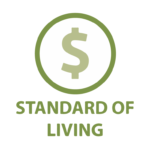
Child Poverty
Community & Family (Cross Age)
Note
*: Statistically unstable
HHSA Regions: Health and Human Services Agency regions
The end of pandemic-era safety net policies, such as the expanded Child Tax Credit (CTC), in addition to increased costs due to inflation in 2021, were responsible for the observed child poverty increase in 2022.
Race-Ethnicity categories:
White Alone, Black or African American. AIAN: American Indian and Alaska Native, Asian, NHPI: Native Hawaiian and Other Pacific Islander, Some Other Race, Multi-Race: Two or More Races, Non-Hispanic White, Hispanic
Data by race and ethnicity includes possible overlap between racial and ethnic groups, as Hispanic includes population of Hispanic/Latino of all races and each racial group includes population of all ethnicities.
Sources:
U.S. Census Bureau, 2013-2017 American Community Survey 5-Year Estimates, Table B17024; U.S. Census Bureau, 2018-2022 American Community Survey 5-Year Estimates, Table B17024.
U.S. Census Bureau, 2013-2017 American Community Survey 5-Year Estimates, Table B17001; U.S. Census Bureau, 2018-2022 American Community Survey 5-Year Estimates, Table B17001.
U.S. Census Bureau, 2013-2017 American Community Survey 5-Year Estimates, Table B17001A-I; U.S. Census Bureau, 2018-2022 American Community Survey 5-Year Estimates, Table B17001A-I.
Prepared by: County of San Diego, Health and Human Services Agency, Public Health Services, Community Health Statistics Unit, 2024.
What is the indicator?
The indicator—the percentage of children ages 0-17 living in poverty—reflects the proportion of children living in households with annual income below federal guidelines for “poverty.” The Federal Poverty Level (FPL) was set at $30,000 for a family of four in 2023. These data are routinely reported by the US Census Bureau.
Why is this important?
Growing up in poverty has profound effects on children’s health, safety, education, and overall well-being, both immediately and over time. The severity of poverty and the duration of exposure amplify these impacts. Poverty exposes children to various risks, such as inadequate nutrition and housing, parental mental health issues or substance misuse, neglect, substandard education and childcare, as well as other environmental hazards in their communities. Adolescents from impoverished backgrounds are more prone to engaging in risky behaviors like smoking, substance abuse, early sexual activity, and dropping out of school. Moreover, experiencing poverty during childhood correlates with lower educational achievements and reduced income levels later in life.
What strategies can make a difference?
These evidence-based strategies are used across the country to address poverty:
- Expand childcare services at job training and educational facilities.
- Increase the utilization of federal and state Earned Income Tax Credits (EITC), child tax credits, and refundable tax credits among qualifying families.
- Increase the minimum wage.
- Provide affordable job training and General Educational Development (GED) programs for unemployed individuals and working parents.
- Increase educational achievement rates and decrease high school dropout rates.